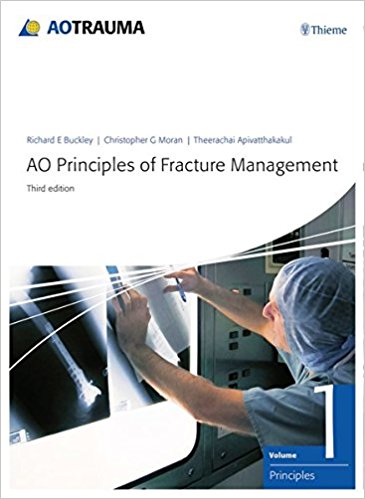
The AO Principles of Fracture Management has served many generations of surgeons around the world as the source of
knowledge and essential reference in the field of orthopedic trauma surgery. The fundamental principles of fracture
surgery have not changed in 60 years, but the biological and clinical knowledge, as well as technological advancements
have extended new possibilities in surgical treatment and offered surgeons the opportunity to explore new ways of
applying the AO principles.
The new third edition of this book has been expanded to include new knowledge and explore state-of-the-art technology.
It also addresses pressing challenges that face orthopedic surgeons today, such as the exponential rise in fragility
fractures resulting from demographic changes and an aging population. The book aims to help surgeons to successfully
rise to such challenges.
Key features include:
* Contributions from more than 50 highly renowned surgeons, scientists, and medical professionals
* More than 2,100 high-quality illustrations and images, as well as access to over 250 video presentations
* New chapters on periprosthetic fractures, knee dislocations, fragility fractures and orthogeriatric care and
additional information on operating room setup and planning
* Immediate access to AO's continually evolving range of online educational offerings via QR codes for mobile devices
including animations, webcasts, webinars, lectures, AO Surgery Reference, AOSTART and more
AOTrauma is pleased to bring you a new expanded, comprehensive, and updated edition of the AO Principles of Fracture
Management for residents, fellows, course participants and faculty, Trauma and Orthopedic surgeons, and operating room
personnel. 
Volume 1-Principles
AO philosophy and basic principles
1.1 AO philosophy and evolution
1.2 Biology and biomechanics in bone healing
1.3 Implants and biotechnology
1.4 Fracture classification
1.5 Soft-tissue injury: pathophysiology, evaluation, and classification
Decision making and planning
2.1 The patient and the injury: decision making in trauma surgery
2.2 Diaphyseal fractures: principles
2.3 Articular fractures: principles
2.4 Preoperative planning
Reduction, approaches, and fixation techniques
Reduction and approaches
3.1.1 Surgical reduction
3.1.2 Approaches and intraoperative handling of soft tissues
3.1.3 Minimally invasive osteosynthesis
Techniques of absolute stability
3.2.1 Screws
3.2.2 Plates
3.2.3 Tension band principle
Techniques of relative stability
3.3.1 Intramedullary nailing
3.3.2 Bridge plating
3.3.3 External fixator
3.3.4 Locking plates
General topics
4.1 Polytrauma: pathophysiology, priorities, and management
4.2 Open fractures
4.3 Soft-tissue loss: principles of management
4.4 Pediatric fractures
4.5 Antibiotic prophylaxis
4.6 Thromboembolic prophylaxis
4.7 Postoperative management: general considerations
4.8 Fragility fractures and orthogeriatric care
4.9 Imaging and radiation hazards
Complications
5.1 Malunion
5.2 Aseptic nonunion
5.3 Acute infection
5.4 Chronic infection and infected nonunion
Volume 2-Specific fractures
Scapula and clavicle
6.1.1 Scapula
6.1.2 Clavicle
Humerus
6.2.1 Humerus, proximal
6.2.2 Humerus, shaft
6.2.3 Humerus, distal
Forearm and hand
6.3.1 Proximal forearm and complex elbow injuries
6.3.2 Forearm, shaft
6.3.3 Distal radius and wrist
6.3.4 Hand
Pelvis and acetabelum
6.4 Pelvic ring
6.5 Acetabulum
Femur and periprosthetic fractures
6.6.1 Femur, proximal
6.6.2 Femur, shaft (including subtrochanteric fractures)
6.6.3 Femur, distal
6.6.4 Periprosthetic fractures
Knee
6.7.1 Patella
6.7.2 Knee dislocations
Tibia
6.8.1 Tibia, proximal
6.8.2 Tibia, shaft
6.8.3 Tibia, distal intraarticular (pilon)
Malleoli and foot
6.9 Malleoli
6.10.1 Hindfoot-Calcaneus and talus
6.10.2 Midfoot and forefoot
Appendix
Glossary
Index


